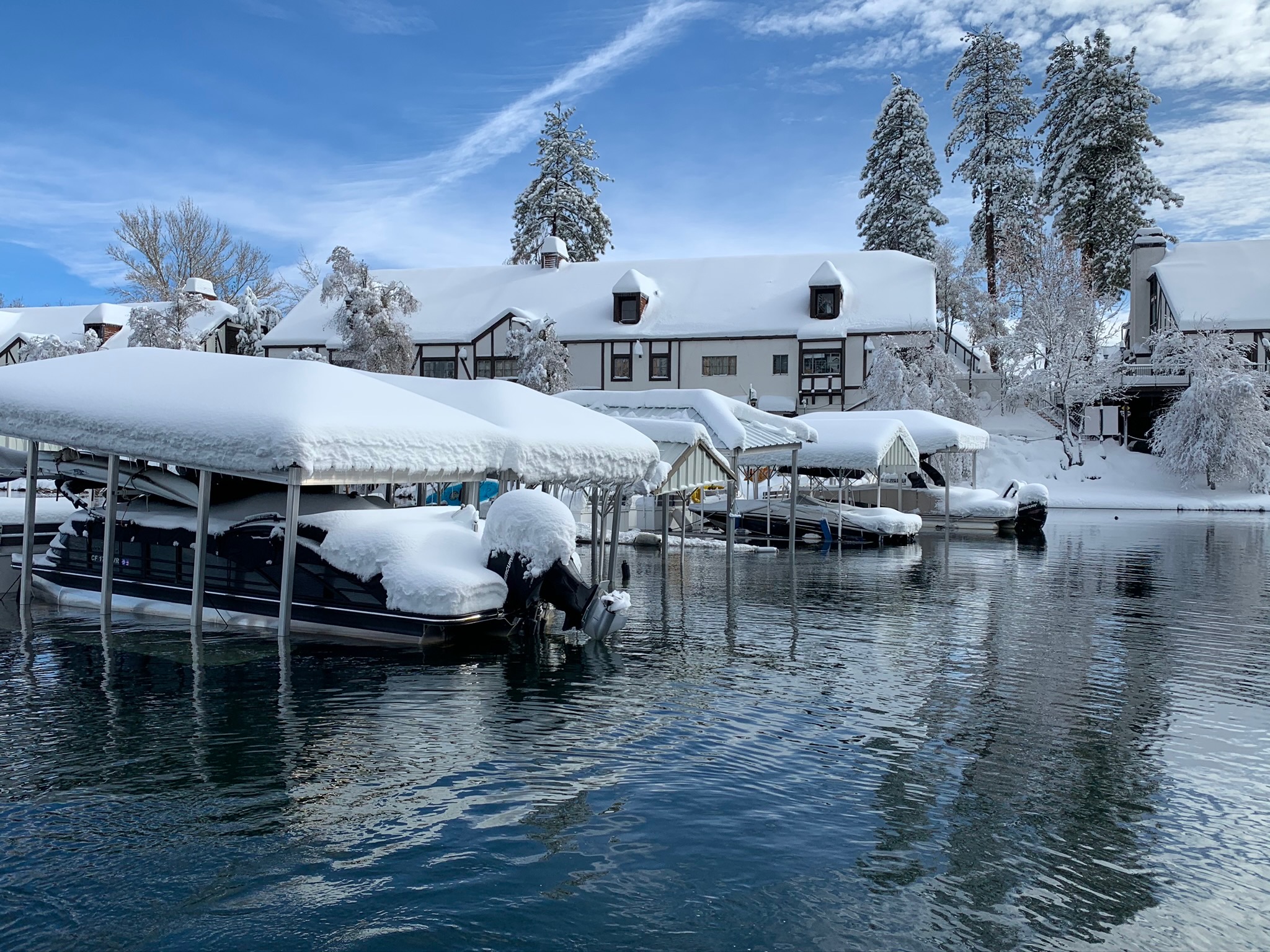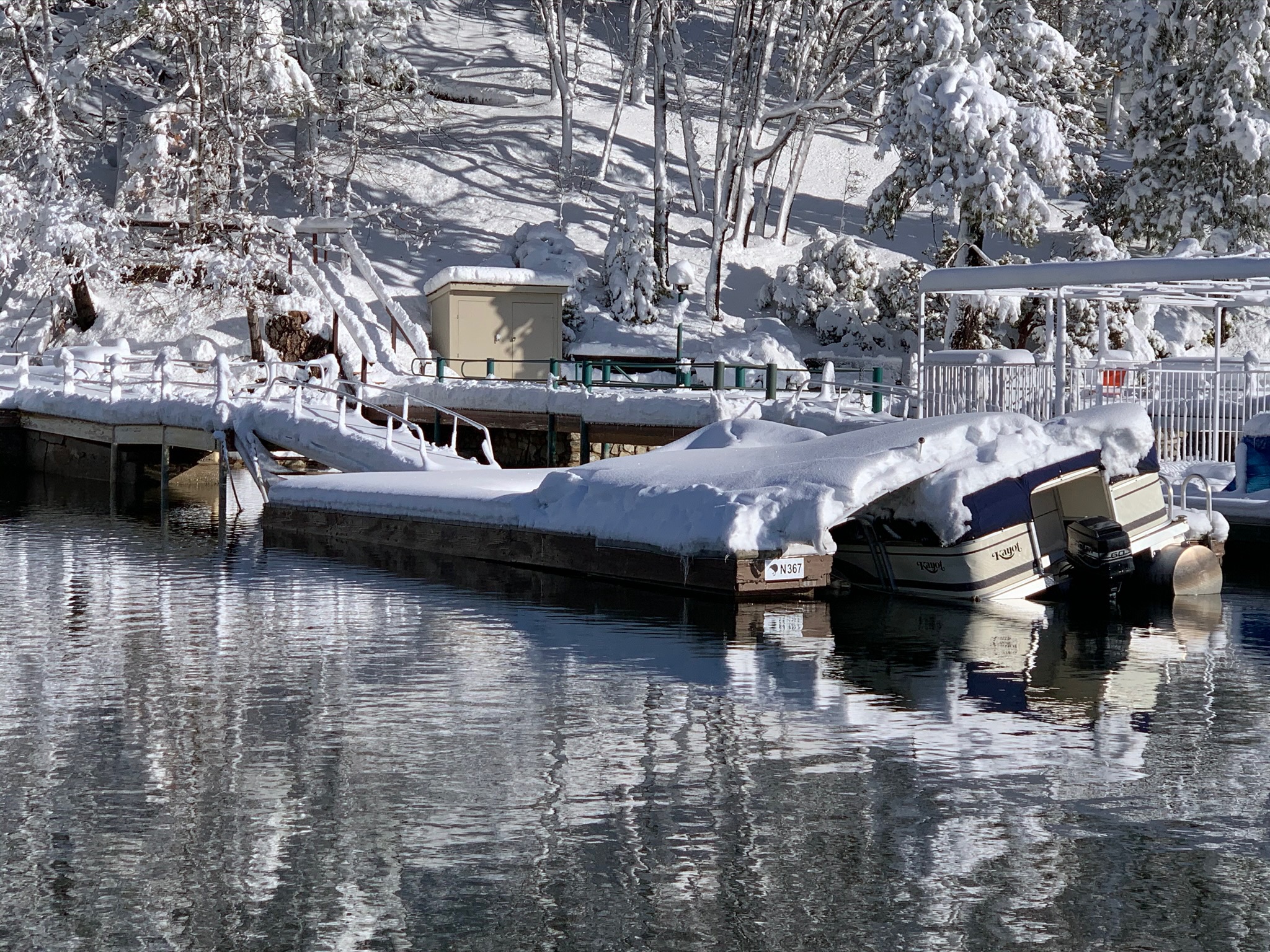Owning a dock in Lake Arrowhead means you’re entitled to enjoy the best of what the lake has to offer—beautiful days in the sun, wakeboarding and water sports, and of course, fishing. But in order to continue receiving the most from your dock, you have to protect it from winter’s most damaging effects. The last thing you want in the middle of the winter is to suddenly find your dock completely submerged or bursting at the seams.
That’s why we put together a list of the worst-case scenarios in the winter that lead to dock problems. Knowing this, you can prepare against anything and everything to ensure amazing winter seasons for you and your family.
Hope for the best, prepare for the worst. That’s our motto.
Winter is Coming
Winter is coming, and this should mean nothing but excitement for dock owners to enjoy Lake Arrowhead’s winter traditions. Unfortunately, with winter comes snow, freezing temperatures, and myriad potential problems for your dock. Problems that, if not properly prepared for, can potentially destroy your dock and ruin winter festivities.
Nestled at an altitude of 5,100 feet, every winter the local pine, cedar, and dogwood transform into a winter wonderland. As the snow comes and goes, the water levels rise and fall. And as the high winds rush in, so does winter’s most damaging effects.
Worst-Case Scenarios that Lead to Dock Problems

While maintenance and repairs can cost you a pretty penny, your first defense against winter dock problems is to understand the various worst-case scenarios.
- Snowfall – For most of Lake Arrowhead, snowfall brings nothing but fun, skiing, sledding, and building snowmen. But for dock owners, it can bring a plethora of potential problems. With every inch of snowfall comes more weight to your dock. This means more force is weighing down on the connection points, specifically increasing the chances of the above connection points breaking or being damaged. In addition, the extra weight causes the dock to sink or float lower than normal. And there is no “worse” worst-case scenario than finding your dock in the middle of the winter completely submerged in freezing waters. This can lead to lead to water absorption into the wood, causing irreparable damage and potential rotting. All of which contribute to severe depression in the wood’s strength and viability.
How to Protect Your Dock: We recommend removing the snow as quickly and consistently as possible to ensure this extra weight does not submerge your dock or damage the wood’s integrity. We also recommend you monitor the lake levels regularly, especially if there is a storm, to ensure that your dock doesn’t go under.
- High Winds – High winds might bring the snow that skiers love at Lake Arrowhead, but it brings dock owners additional wear and tear. More specifically, the dock’s connection points bear the force of the gusting winds. The force of the winds also generates larger waves in the lake, which creates problems for older or worn out connector hinges and sway chains that keep your dock at bay. The worst-case scenario is you were unable to catch these problems before they occur and your dock breaks loose, damaging itself and possibly neighboring docks. The last thing you want is to have to tell your neighbor, you not only damaged your dock but theirs too.
How to Protect Your Dock: Your best course of action will be to use Kiwi Dock’s dock watch program to monitor your dock. Regular monitoring will help to prevent any foreseeable damage. However, if you do notice any signs of wear or tear, contact someone for dock repair immediately. Repairing your dock early on can help prevent your dock from floating away.
- Rain and Snow – Rain and snow, shouldn’t that be the same as snowfall? Actually no. When it comes to weather, nothing is predictable. That means some days and nights you’re going to get a mix of rain and snow. Sleet and slush can potentially damage your dock’s wood integrity just like pure snowfall. However, with the rain and snow working against each other, the melting and freezing and runoff from both will affect the water levels of the lake and cause erosion around your seawall and pier. As water freezes, it expands, which can cause damage to any structure that the rainwater collects in. Additionally, when rain is coupled with wind, it leads to a stronger driving force that brings more strain to your dock. Therefore, as the levels rise, your dock needs to be checked, adjusting the sway chains and moving gangway up as needed. You also want to avoid any binding points or connection points being submerged from intense rainfall to avoid water absorption to the dock and rust to metal connection points.
How to Protect Your Dock: We recommend you regularly check lake levels and inspect connection points of your dock to adjust accordingly.
It helps to always stay conscious of weather reports and their implications and act accordingly. That way you can avoid costly repairs. Speaking of…
Why Repair & Maintain Your Dock?
As a Lake Arrowhead dock owner, you want to enjoy the benefits of why you own a dock in the first place. Repairing your dock correctly when needed and with the help of professionals can bring many years of long-lasting dock life. And as always, it’s about putting safety first.
Whether you owned a dock for decades or this is your first winter season, the safety risks to you and your dock remain the same. Repairing your dock ensures that you and your family are safe and ready to enjoy everything that owning a dock in Lake Arrowhead has to offer.
Maintenance & Regular Monitoring
It’s not always about the winter that’s in front of you. Maintaining your dock is about protecting your dock for multiple seasons. Regularly maintaining your dock and boat will ensure you and your family can enjoy everything your dock has to offer. But doing so will take foresight and regular monitoring.
Here are some helpful regular maintenance and monitoring tips to ensure your dock stays in pristine condition:
- Applying a fresh coat of paint/stain every 1-2 years
- Ensure the proper floatation to keep the dock high and out of water
- Any complex maintenance or repairs should be conducted by professionals
- Regularly inspect your dock, pier, and accessories for any signs of damage
- Always properly set your sway chains
- Move your dock up or down, as needed, if lake level changes
- Be a good neighbor: help each other dock watch against unpredictable weather
- Conduct annual inspections to catch problems before it’s too late
- Check out our article with top tips for keeping your dock in good shape!
Prepare your dock for the worst-case scenarios in the winter so you can enjoy the best-case scenarios all year long.
Sources:
Kiwi Docks. Top Tips for Keeping Your Dock in Good Shape. https://www.kiwidocks.com/2019/04/25/top-tips-for-keeping-your-dock-in-good-shape/
On Lake Arrowhead. The History and Appeal of Lake Arrowhead. http://onlakearrowhead.com/jmhistory.html

